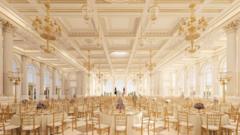Traditionally, large formal functions at the White House are hosted in the East Room, which only seats 200 guests. The need for large tents on the South Lawn to cater to bigger gatherings has often been deemed less than ideal. The construction of the new ballroom aims to address this need, eliminating the reliance on temporary structures for events that frequently include prominent global leaders. Chief of Staff Susie Wiles expressed that the ballroom represents not just a practical solution, but also a commitment to preserving the historical essence of the White House.
Architectural renderings show the ballroom designed in a style that complements the existing structure, featuring chandeliers and ornate columns. However, experts, including Leslie Greene Bowman from the Committee for the Preservation of the White House, stress the importance of maintaining the historical integrity of the building amidst plans for modernization. The First Lady's office and others in the East Wing will temporarily relocate during construction.
The ballroom project evokes a past moment when Trump, in 2016, offered to fund a similar initiative, which was dismissed by then-President Obama’s administration. During this week's discussions, Trump reiterated his commitment to creating a space for hosting significant events, emphasizing the historical significance of having a dedicated ballroom.
As anticipation builds for the new addition, the implications for the White House's storied legacy remain a focal point of discussion. The project's successful implementation will not only be a showcase of architectural beauty but also a testament to how modern administrations navigate historical spaces in the heart of American democracy.
Architectural renderings show the ballroom designed in a style that complements the existing structure, featuring chandeliers and ornate columns. However, experts, including Leslie Greene Bowman from the Committee for the Preservation of the White House, stress the importance of maintaining the historical integrity of the building amidst plans for modernization. The First Lady's office and others in the East Wing will temporarily relocate during construction.
The ballroom project evokes a past moment when Trump, in 2016, offered to fund a similar initiative, which was dismissed by then-President Obama’s administration. During this week's discussions, Trump reiterated his commitment to creating a space for hosting significant events, emphasizing the historical significance of having a dedicated ballroom.
As anticipation builds for the new addition, the implications for the White House's storied legacy remain a focal point of discussion. The project's successful implementation will not only be a showcase of architectural beauty but also a testament to how modern administrations navigate historical spaces in the heart of American democracy.



















